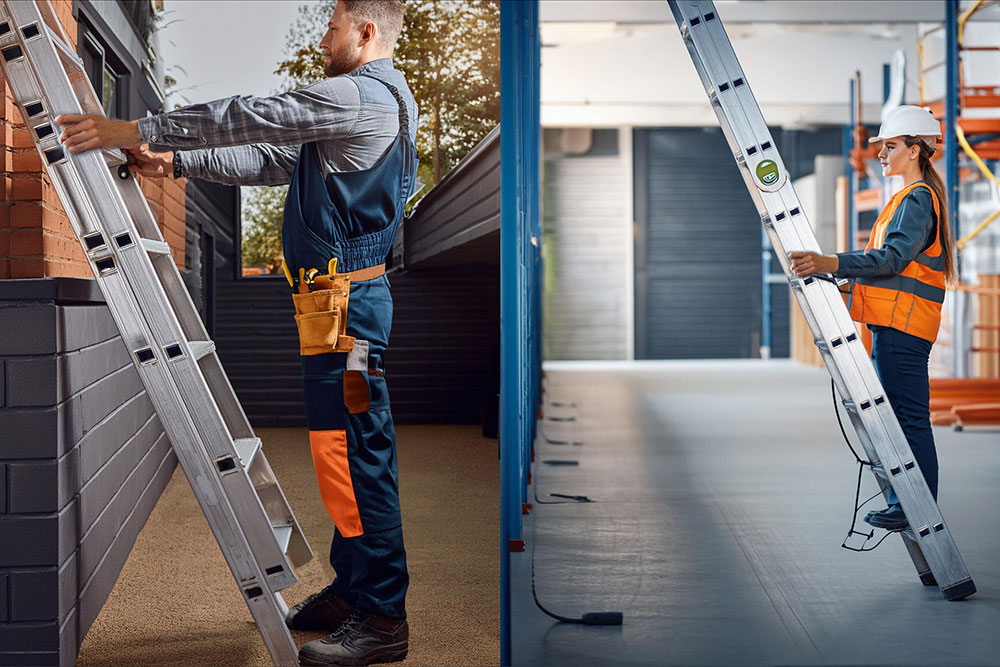
Footing a ladder seems like an obvious way to prevent it from slipping. But of all the methods you can use to secure a ladder, it’s considered the least effective. And the most widely used footing technique isn’t ever recommended.
Our guide explains how to foot a ladder properly and why footing is a last resort. It also covers ladder safety best practice and how you can be sure your ladder is placed, set up and secured according to regulations.
Ladder Safety Regulations
First, the use of a ladder is absolutely allowed in workplaces. Some people maintain that ladders are banned by the Health and Safety Executive (HSE) because people can’t be trusted to use them safely. This is untrue.
There is no blanket restriction, and ladder users do not need to be specially qualified. However, there are regulations you must follow.
The Work at Height Regulations 2005 (WAH Regulations) state that all work at height must be planned, supervised and carried out safely.
So, before any ladder work can begin, a competent person must have assessed the task and determined that a ladder is a safe and practical option for reaching the necessary height. It’s not a fixed rule, but ladders should generally only be used for short (less than 30 minutes), low-risk tasks.
You must also be sure the type of ladder you choose is appropriate for the work. It needs to be strong enough to support the worker, plus their tools and materials, and tall enough to extend past the work area. It’s unsafe to work from the top three rungs of a leaning ladder or the top three steps of a step ladder, so remember this when choosing your equipment.
Competence
While you don’t need qualifications, you must be competent to use a ladder. You need the knowledge, experience and training to assess the risks and plan how to eliminate or control them.
So, you’ll need to know how to secure a ladder properly to work safely and in compliance with the WAH Regulations. We’ve explained methods below, including how to foot a ladder. We’ve also highlighted general safety advice you’ll need to follow when using a ladder for work.
Checking Your Ladder
You should carry out a pre-use check of the ladder before starting work. Having the manufacturer’s instructions on hand is helpful, as it gives you something to compare against, but pre-use checks are relatively light. You must be trained to carry them out, however.
A compliant pre-use check will cover the:
- Stiles
- Feet
- Rungs
- Locking mechanism
- Platform (stepladders only)
- Steps or treads (stepladders only)
If the ladder has any visible defects, do not use it.
In addition to pre-use checks, ladders should undergo regular inspections. Inspections are more in-depth, so you need more extensive training, knowledge and experience to conduct them.
Placing Your Ladder
You must only ever place your ladder on ground that’s solid, clean and level.
Check the area for spills or loose materials that could cause your ladder to slip, such as:
- Sand
- Moss
- Leaves
- Loose flooring/carpets/rugs
- Packaging materials
- Spills, such as oil or cleaning supplies
(Some floors are inherently slippery, even if they’re in good condition.)
Levelling devices can help when ground conditions aren’t ideal. You can use these devices on slanted surfaces to create a stable base for your ladder. But they cannot be improvised. Only deploy proper levelling devices you’ve been trained to use.
You must also be aware of your environment. Vehicles or pedestrians bumping into the base of your ladder can cause it to fall. Windows or doors opening unexpectedly towards the top of your ladder can do the same.
Check that the top of your ladder is clear of any potential openings or loose fixtures. Cordon off the base of your ladder with cones and warning signs. At a push, you could station a colleague on the ground to alert approaching drivers and pedestrians.
Setting Up Your Ladder
Each ladder type and design is different, so follow the manufacturer’s instructions when setting up.
With that said, there are universal safety rules you should follow:
- Follow the 1-in-4 rule for leaning ladders: For every four units of height up, move the base of the ladder one unit away from the wall. For example, if your ladder is leaning against a wall at a height of 8 metres, set the base of a ladder 2 metres from the wall.
- Check that your ladder extends at least three rungs (around 1 metre) past the work area. It’s unsafe to work from the top of any ladder type.
- Never place anything under a ladder to boost its height. Similarly, never set up a ladder on top of scaffolding or a mobile elevated work platform if it’s too short.
- Lean ladders against stable surfaces (look out for gutters, plastic windowsills, etc.) Use a stand-off device if necessary.
- Ensure ladders are always set up on a level, stable surface. You can use levelling devices to set up a ladder safely on uneven ground but never improvise. Using pallets, bricks, or any other makeshift ‘levelling devices’ to try and stabilise the base of your ladder only ever increases the risk of it tipping.
Securing Your Ladder
There are four primary methods of securing a ladder. Each technique will help prevent a ladder from falling, but there’s a clear hierarchy of most preferred to least preferred:
- Tying the stiles
- Using a stability device
- Wedging the ladder
- Footing the ladder
How to Tie the Stiles
Tying the stiles is the safest, most preferred option. Tie both stiles of the ladder to a fixed point. (Never tie the rungs, as these aren’t strong enough to prevent the ladder from falling.)
You can tie the stiles towards the top of the ladder or further down towards the base, provided the anchor point is secure.
Ladders used for access to another level should always be secured this way.
How to Use a Stability Device
There are various stability devices to choose from, including:
- Spreader bars
- Base supports
- Stand offs
Follow the manufacturer’s guidance for whatever device you choose, and ensure it’s in safe working order before use. If you’re not trained to use a device, have someone competent supervise.
How to Wedge a Ladder
Find something solid to wedge the stiles against, such as the wall of a building.
How to Foot a Ladder
Footing a ladder is the least effective way to secure it, so consider all other methods first. If none of them are workable, ask a colleague to assist you and foot the ladder.
There are two methods of footing depending on how the ladder might fall:
- If the base might slide out away from the wall, place both feet on the ground with toes against the stiles to create a barrier. Grip both stiles with your hands for added support.
- If the ladder might tip over, stand with both feet on the bottom rung and both hands on the stiles. The extra weight at the base of the ladder will help keep it steady, but be wary of overloading.

The traditional method of placing one foot on the ground and one foot on the bottom rung isn’t as effective at preventing a ladder from falling.
When work has finished, the person footing the ladder should remain in place until the climber has safely descended past the halfway point.
How to Foot a Ladder & Other Safety Essentials – Key Takeaways
- Follow the Work at Height Regulations 2005 to ensure all work at height is planned, supervised and carried out safely.
- Perform pre-use checks before starting work. You must also regularly inspect ladders for less obvious defects or damage.
- Place the ladder on solid, clean and level ground, and use proper levelling devices if necessary.
- Secure the ladder by tying the stiles, using stability devices, wedging it against something solid or, as a last resort, footing it.
Ladder Inspection Training
Understanding how to secure and safely use ladders is crucial, but equally important is ensuring your ladders are in good condition.
Our online Ladder Inspection Training course teaches you how to identify faults and conduct thorough inspections in line with regulations. You’ll also learn how to record and report your findings effectively. Completing this course develops competency in ladder inspection and helps maintain a safe working environment.


















































































































































































































































































































































































































































































































































































































































































































































